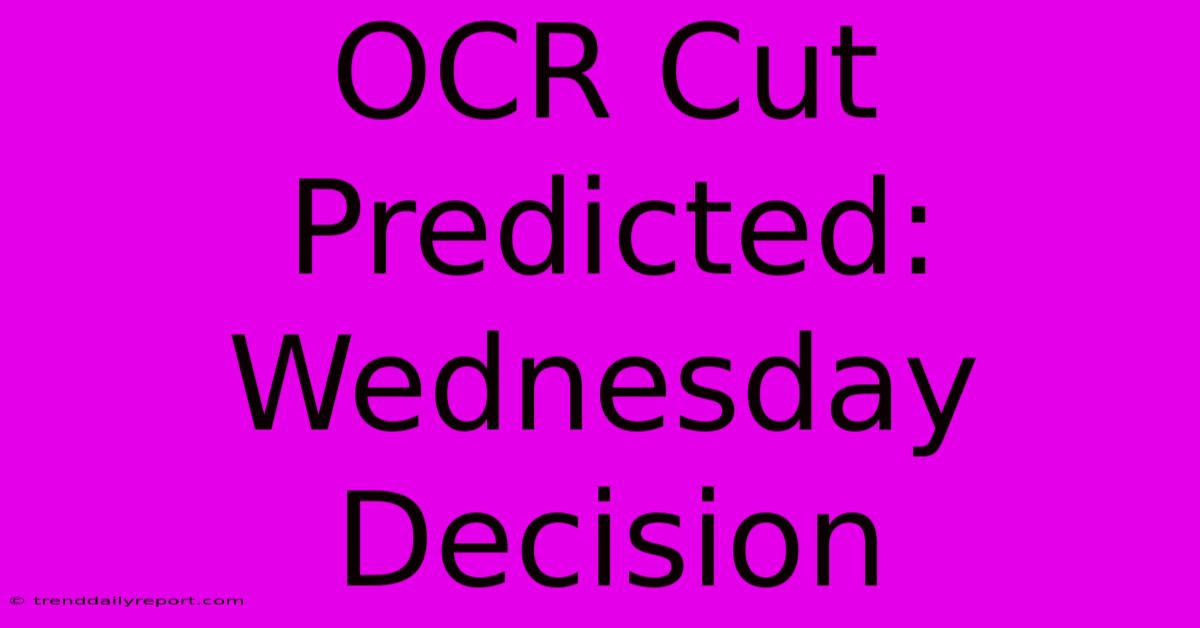OCR Cut Predicted: Wednesday Decision

Discover more detailed and exciting information on our website. Click the link below to start your adventure: Visit Best Website OCR Cut Predicted: Wednesday Decision. Don't miss out!
Table of Contents
OCR Cut Predicted: Wednesday Decision - What it Means for You
Okay, folks, buckle up, because this is a rollercoaster. We're talking about the Optical Character Recognition (OCR) cut, the one everyone's been buzzing about, and the predicted decision dropping this Wednesday. I've been following this closely – honestly, way closer than I probably should have been, given my already overflowing to-do list – and I'm here to break it down in plain English. No tech jargon, just real talk.
My OCR Nightmare (and how I survived it)
Let me tell you a story. A few years back, I was knee-deep in digitizing my grandma's old recipe books. Thousands of pages, handwritten in spidery script. I thought, "Piece of cake! OCR software will save the day!" Boy, was I wrong. The software? Total garbage. I'm talking about 80% accuracy, maybe less. Words were mangled, sentences were nonsensical, and I spent hours correcting its mistakes. It was excruciating. Seriously, I nearly threw my laptop out the window.
That experience? It taught me a lot about OCR, and about choosing the right tools for the job. It also drove home the importance of understanding the limitations of this technology. It's not magic, people.
What This Wednesday's Decision Could Mean
So, back to the impending decision. The whispers are all about potential cuts to OCR funding. If this happens, it could mean several things:
- Higher Prices: Less funding often translates to higher prices for OCR software and services. That means businesses and individuals will need to dig deeper to get the same level of accuracy and efficiency. This is a bummer.
- Slower Development: Less money equals slower innovation. We might see fewer improvements in accuracy, speed, and functionality. The current progress with AI-powered OCR tools, and that's a BIG deal.
- Reduced Accessibility: OCR is crucial for accessibility, allowing visually impaired individuals to access digital information. Cuts could directly impact their ability to use this technology. This is serious.
Tips for Navigating the OCR Landscape (Whatever Happens)
Regardless of Wednesday's decision, here are some things you can do:
- Research Different OCR Software: There are tons of options out there, from free and open-source programs like Tesseract OCR to cloud-based services like Google Cloud Vision API. Don't just settle for the first one you find. Try out a few and compare their accuracy and features. It's worth the effort.
- Pre-Process Your Documents: Clean, clear documents make OCR much easier. Remove staples, straighten out crooked pages, and make sure your scans are high-resolution. These small changes help make the data usable and readable. This is important!
- Always Proofread: Even the best OCR software makes mistakes. Always review the output carefully and correct any errors. Trust me; it's worth it. I learned that lesson the hard way!
- Consider Outsourcing: If you're dealing with a large volume of documents or complex handwriting, consider outsourcing the work to a professional data entry service. It might cost more upfront, but it can save you time and frustration in the long run.
Stay Informed!
The OCR world is constantly evolving. Keep your eyes peeled for updates, and don't hesitate to ask questions. It’s okay to reach out to other people in the industry and to ask for help. This Wednesday's decision is just one piece of the puzzle. The future of OCR is still being written.
This article is for informational purposes only. Always do your own research and consult with relevant professionals before making any decisions.

Thank you for visiting our website wich cover about OCR Cut Predicted: Wednesday Decision. We hope the information provided has been useful to you. Feel free to contact us if you have any questions or need further assistance. See you next time and dont miss to bookmark.
Featured Posts
-
Trump Names Nih Director Bhattacharya
Nov 27, 2024
-
Lakers Suns Game Le Bron Ad Grades
Nov 27, 2024
-
Elections Ns Website Outage
Nov 27, 2024
-
Bayern Vs Psg Todays Starting Xi
Nov 27, 2024
-
Barcelona Dominates Brest Game Report
Nov 27, 2024
